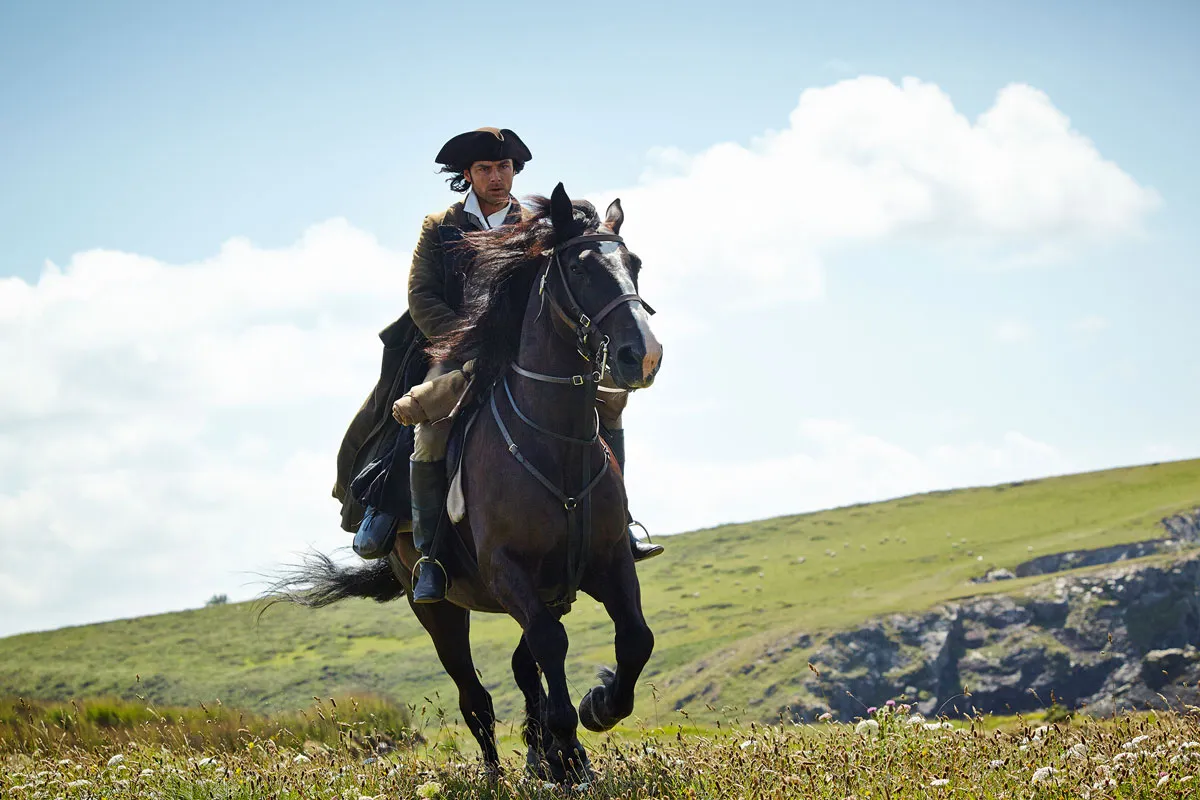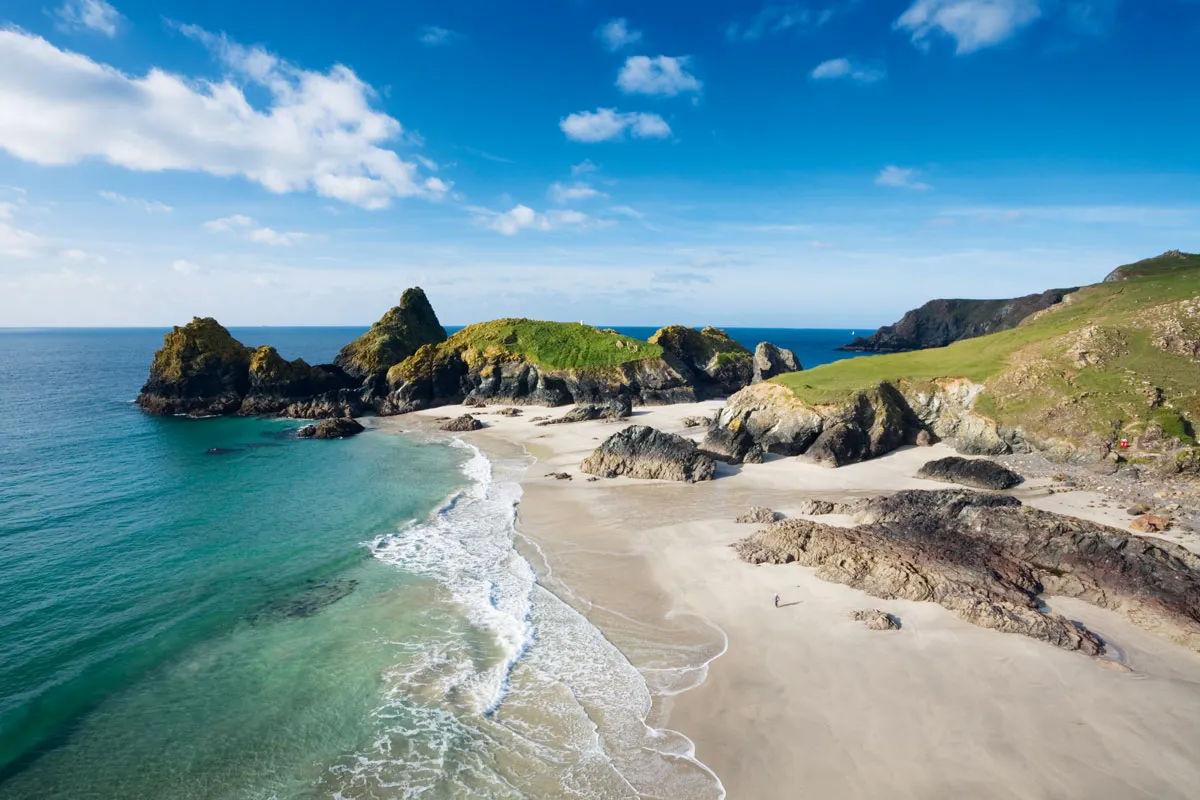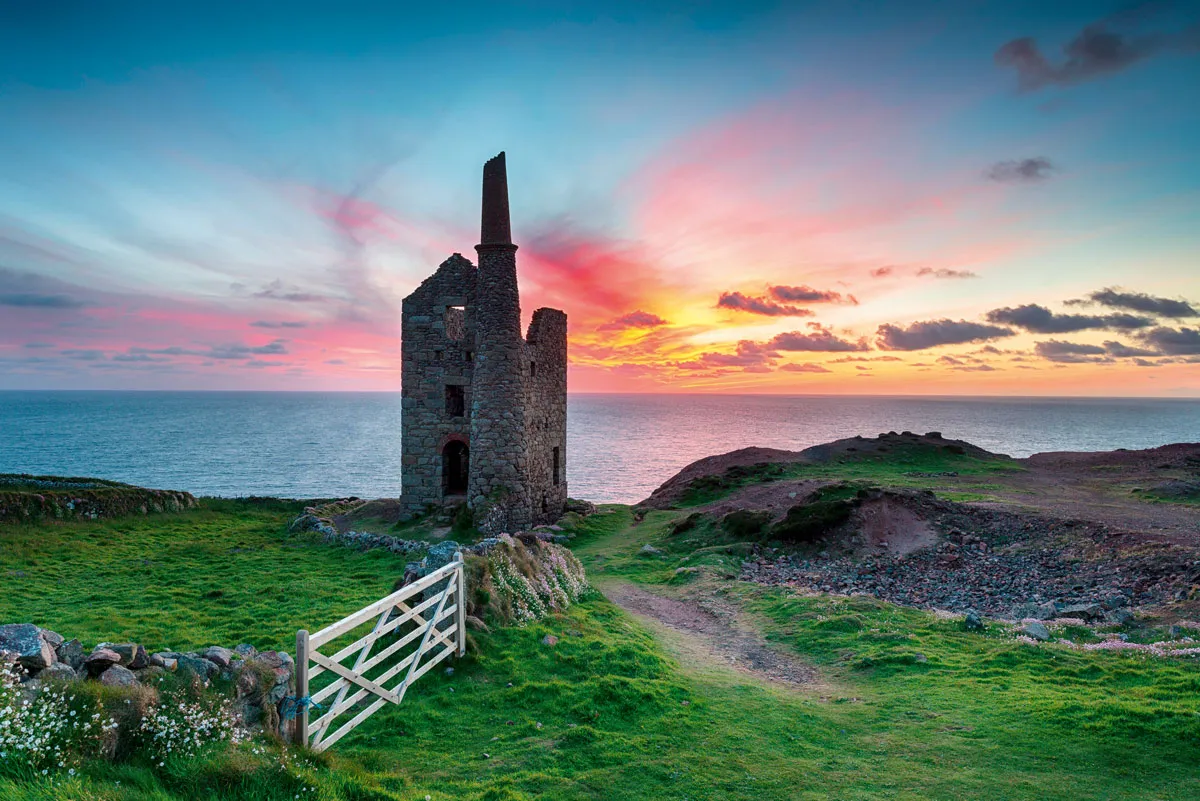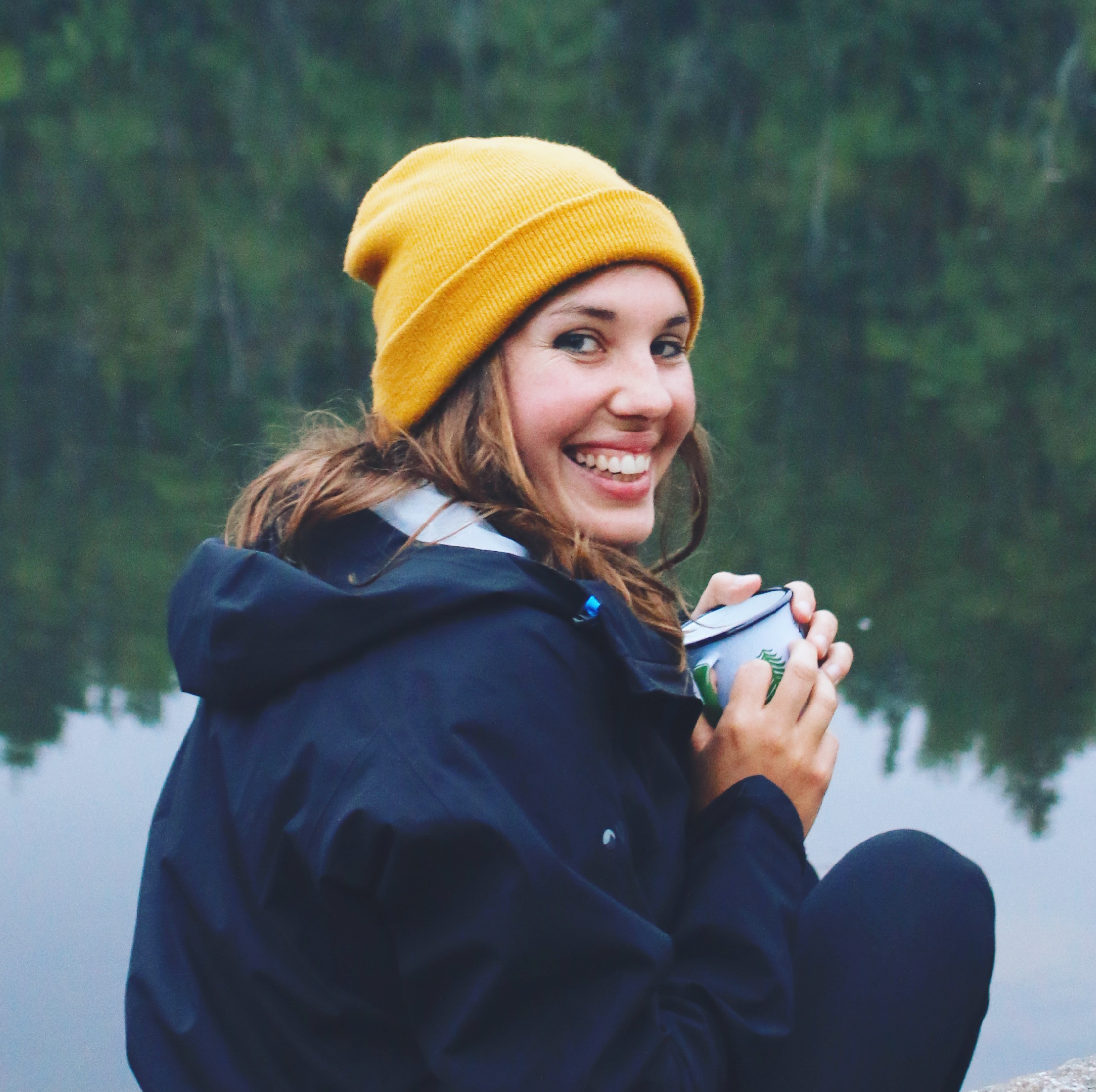A figure stands on a cliff in a tricorn hat and billowing cape, gazing moodily out at the waves that crash hungrily at the foot of the rocks. The man is thinking of the girl he married and the woman he lost, and the wild Cornish landscape around him echoes the turmoil in his mind.
Ross Poldark is the brooding hero of Poldark: A Novel of Cornwall, Winston Graham’s 12-novel saga – the celebrated adaptation of which returns to BBC One for a second series in September.

Graham’s tale describes the Poldark family’s fortunes through the tumultuous 18th and 19th centuries in rural Cornwall. It begins as Ross returns home from war to find his father dead, his house in ruins and the love of his life, Elizabeth, about to marry his cousin.
After much galloping around on dramatic, stormy moorland, Ross sets about rebuilding his life, trying to find fortune by reopening the family copper mine, the curiously named Wheal Leisure. He meets a young waif, Demelza, employs her as a scullery maid and then falls in love with her, to the scandal of polite society.
The man behind the drama
Graham found inspiration for the Poldark novels in the Cornish landscape, publishing the first in 1945 while living in Perranporth. “I moved from Lancashire with my family when I was 17 and I fell in love with the countryside immediately,” he wrote. “I found the whole atmosphere and the history exciting and romantic.”
Today Perranporth is famous for its huge beach – three miles of pale sands that face the Atlantic Ocean, ending in the rock stacks and jagged cliffs of Ligger Point. Graham was a coastguard here during the Second World War, and hours of keeping watch inspired him to re-cast Perran Sands as the fictional Hendrawna beach in the novels.
As throngs of families and surfers play in the sunshine, it is strange to think that in the 1700s of Poldark’s era, Cornwall was a perilous world of smuggling and hard labour in the tin and copper mines.
Graham’s tale unfolds against a backdrop of poverty and injustice: the weather and landscape often reflect the mood of his protagonists. But as love blossoms, we move from Ross’s dark moors – inspired by Bodmin Moor’s granite tors and rough, windswept landscape – to Demelza’s sunlit meadows, where she marvels at blooming hawthorns. You can instantly picture her in the softer, shady green landscape around Helford and the River Fal, Cornwall’s Eden, or in the wooded Vale of Lanherne, where Graham liked to imagine ancient Cornish families visiting the 13th-century church tucked away in the village of Mawgan-in-Pydar.
The “riots of bluebells and campion and white flowers” that burst into life in Cornwall in spring thrilled Graham; and wandering parts of the South West Coast Path in May or June, you can see why. The Lizard Peninsula between Landewednack and Mullion is one of Cornwall’s most famous wildflower habitats, with high grassy downs speckled with sea campion, thrift and kidney vetch – you can almost see Demelza and her faithful dog, Garrick, asleep among them.
Our hero appears
1945 was, perhaps, the right time to pen a book such as Poldark. At the end of the Second World War, Britain was searching for distraction from the horrors of the conflict and the difficulties of eking out an existence on rations. As a reader, there is an escapism in Poldark, a joy in running away to a simpler life by the sea. And we all love a hero in tough times – Graham once said that the character of Ross was based upon a wounded fighter pilot he met on a train during the Second World War.
While the books are still loved by many readers, it has been the two BBC adaptations for television that brought Poldark fever to the public. The first seven Poldark novels were adapted as a BBC television series broadcast in the UK between 1975 and 1977, attracting enormous audiences that peaked at 14 million viewers. Poldark was so popular that some vicars would reschedule church services to avoid clashing with broadcasting times. Viewers still speak fondly of the first adaptation but it’s the second Poldark creation, first aired in 2015 and with a second series starting this autumn, which is arguably truer to the books and captures the mix of untouched wildness and cosy charm that made Graham’s creation so readable.
Poldark’s places
The elegant stately home of Trerice was Graham’s inspiration for Francis and Elizabeth Poldark’s pile, Trenwith. And Graham must have named the dastardly family Warleggan, enemies of the Poldarks, for the moorland village of the same name – the most remote in Cornwall. It is a ghostly, mist-covered place where the last vicar is said to have spent 20 years preaching each Sunday to an empty church.
Many other locations in the books are fictional but both TV adaptations have chosen their real-life counterparts well.
On the north Cornwall coast, ruggedly beautiful St Agnes Head, a stone’s throw from Perranporth, where Graham wrote
the books, becomes Nampara Valley. Ross’s lonely house, Nampara, a stone cottage in a remote valley, is reimagined on the windswept and heather-strewn Bodmin Moor.
Some of the locations named in the books are real, of course. The tiny city of Truro is referred to in the books as “a secretive, important little town, clustering in the fold of the hills astride and about its many streams”. Truro today is a charming place, with cosy coffee shops clustered around its cathedral. Charlestown is given the role of Truro in both BBC adaptations of Poldark, and it’s easy to see why – a location manager’s dream, it’s an amazingly unspoiled example of a late Georgian working port, usually with square-rigged ship bobbing proudly in the harbour.
If you’re searching for drama, though, swap Cornwall’s elegant towns for the coast. Gunwalloe on The Lizard peninsula was the setting for a late-night shipwreck scene in the last Poldark series and features again in this series. It’s starkly lovely in stormy weather.
Even more spectacular is nearby Kynance Cove, where huge rocks rear from the water like giants and the sea below collects in crystal-clear little coves, including the Mermaid’s Pool, a heaven for wild swimmers. Scenes from the second season were filmed here, although now the film crews have gone, you’re more likely to find it inhabited by inquisitive grey seals.
To the sea
The sea, of course, is ever-present in the Poldark books. Graham would seek inspiration up the coast at Bedruthan Steps, which he wrote had “ten miles of marvellous cliff scenery and thousands of miles of water; you are looking out over the hazy rim of the world, with no land between this and Alaska.”

To put yourself in Graham’s walking shoes, take a ramble along Porth Joke. This sandy beach just five miles from Newquay is a world away from the summer crowds and what Graham called the “bungaloweczema” that was spreading over his much-loved county, forcing him to search out secret spots where he could stride the coast in peace. He described an evening on the beach here, in which, as the sun slipped away “the sand rippled as regular as lines in a child’s exercise book. Barley and wheat ripened in the sloping fields nearby.” He wrote that when he took permanent leave of Cornwall, he would wish it be an evening and a place like this one.
My favourite passage in the Poldark books is a beautiful sea scene in which Ross and Demelza row out onto the water at moonlight to watch the fishermen bring in the pilchard catch. It’s a wonderful moment, in which hundreds of boats lit by lanterns float together in the moonlit cove. This is the fictional Nampara Cove at the foot of Ross’s property and his haven – he comes here to wash away his problems in the seawater. Graham describes the cove lovingly – the waves are “shadows, snakes under a quilt, creeping in almost unseen until they emerged in milky ripples at the water’s edge”.
The closest thing in real life is romantic Porthgwarra Cove, where the BBC filmed scenes of the pilchard catch and Demelza spying on her lover swimming naked. A miniscule but lovely beach cut out of the cliffs, the rocks above are a riot of sea pinks and the water is a milky blue and perfect for a swim. There is even a secret tunnel running through the rocks to the next tiny cove.

These lands look dramatically different when viewed from the water. Koru Kayaking can take you around the coves and secret caves of St Agnes. Above you, Wheal Coates, one of Cornwall’s most iconic mines, stands proud on its rocky outcrop.
This old heart of mine
A stark contrast to the wide open spaces above ground is the dank darkness of the old Cornish mines, which play a dystopian role in the books – many of Ross’s friends go to work in the mines in their teens and are ruined by the backbreaking labour.
Some mines are now available to visit, and one of the most fascinating is Levant Mine, run by the National Trust, where huge oily engines still run and some shafts are open to walk down – it only takes a few steps to get a glimpse of what a desperate existence this was. The Cornish Mining World Heritage Site also offers information on different mining sites across Cornwall.
You could argue that Cornwall, despite its myriad literary depictions, is not a romantic setting in a cosy, roses-round-the-door sense, and writers searching for inspiration for a sweet little love story might choose the perfect thatched cottages of Dorset or Devon. But for books of wild men, of passion, of lives lived and lost by the bounty of land and sea, there’s nowhere like Cornwall, as Graham well knew. It’s impossible to imagine that Poldark could have been set anywhere else.
MORE INFORMATION
Plantlife on The Lizard www.plantlife.org.uk/wild_plants/important_plant_areas/the_lizard
Trerice www.nationaltrust.org.uk/trerice
Levant Mine www.nationaltrust.org.uk/levant-mine-and-beam-engine
Cornish Mining www.cornish-mining.org.uk
Koru Kayaking www.korukayaking.co.uk
